

Wearable Technology. Wearable Devices Magazine - The Authority in Wearable Technology. Wearable technology: Going out on a limb. Contactless payments are a relatively new but well known phenomenon; in the UK consumers spent more than £2.5bn via the technology in the first half of 2015.

Transport for London adopted the technology in September 2014, and in the first year of operation 180 million journeys were paid for by contactless. Since July of this year, customers have been able to use Apple Pay via their iPhones to pay for travel or after work drinks. However, to use their “mobile wallet” the customer must still extract their phone, authenticate the payment with a fingerprint, and in doing so advertise that they are carrying a device worth upwards of £450. Arguably this is no more efficient (or safe) than tapping a contactless debit or credit card onto a card reader. Indeed in North America, where consumers have access to the largest range of mobile payment systems, just 18% of people regularly make payments via their smartphone. Wearable Payments. How Wearable Technology Works. In the very recent past, using a computer meant sitting at a desk or toting around your laptop bag.
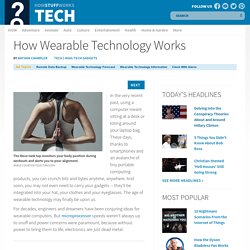
These days, thanks to smartphones and an avalanche of tiny portable computing products, you can crunch bits and bytes anytime, anywhere. And soon, you may not even need to carry your gadgets -- they'll be integrated into your hat, your clothes and your eyeglasses. Lexinnova wearable. Apple Watch. The Future of Wearable Technology is Bright, Here Are Some Reasons Why. For years now, wearable devices have promised to help us lead healthier lives, experience life in new ways, and become less dependent on our smartphones. 2015 was a very important year for wearables as the market took several important steps towards delivering on these promises.
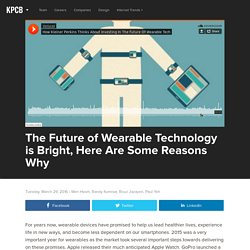
Apple released their much anticipated Apple Watch. GoPro launched a host of new action camera products. FitBit went public with a market cap of over $6B. And Oculus and Microsoft solidified their plans for Rift and Hololens, respectively. Despite the positive momentum, the expectations of the market have not yet been met, as many of these wearable devices will be found tucked away in a drawer or a nightstand after only a few weeks of use. Battery Life is King Battery life is by far the biggest obstacle preventing broad market adoption and retention. Unfortunately, this ultimately leads to underwhelming wearables functionality and feature set.
The Future of Wearable Tech. I have a confession to make.
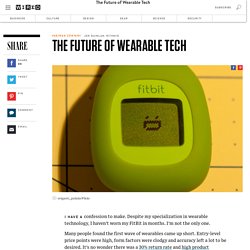
Despite my specialization in wearable technology, I haven’t worn my FitBit in months. I’m not the only one. Many people found the first wave of wearables came up short. Entry-level price points were high, form factors were clodgy and accuracy left a lot to be desired. It’s no wonder there was a 30% return rate and high product abandonment after six months. Companies found getting wearables “right” is a tall order. Invisible. Companies like AiQ Clothing, Hexoskin and OMsignal are already paving the way with biometric garments that measure body vitals. Personalized. The Future of Wearable Tech- Business News. Technology. Information Technology: Impact on the Economy. Technology and the Environment - Importance. Technology as a factor in resource usage Environmental degradation can be described as a product of population, resource use per person (affluence) and environmental damage per unit of resource used (technology).

In the negotiations leading up to the Earth Summit in Rio de Janeiro in June 1992, the USA wanted to remove all references to consumption (resource use per person) from the Agenda 21 document&emdash;the proposed plan of action for the 21st century. The Bush administration would not brook suggestions that lifestyles would need to change in affluent nations. 'The American lifestyle is not negotiable,' George Bush said (Mathews 1992). Low-income nations retaliated by removing references to the urgent need to slow population growth. This view is generally held across the spectrum of political views. Some questions remain to be addressed, however. Back to top... Technological Advancements and Their Effects on Humanity - Use of Technology. Our personal life is highly dependent on the technology that people have developed.
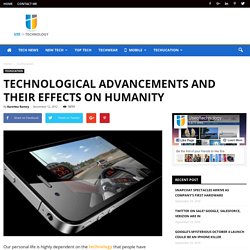
Technology has advanced with years and it has changed the way we purchase products , the way we live , the way we communicate , the way we travel , the way we learn and so many changes have been brought about by these continuous technological advancements. As people’s demands and life style change, the demand for advancing the type of technology we use is high. Almost every thing we use has been innovated to better standards, a good example is the ”Mobile Phone ”, the type of mobile phones we had in 1995 are no longer on demand in this century, the demands of mobile phone users have changed greatly, and this has resulted in the advancement of mobile phone technologies. Technological advancements have helped businesses and organizations save time and cost of production, which has been an advantage to all business, they manage these advancements to gain competitive advantage. Wearable Technology.
Wearable technology. Wearable technology, fashionable technology, wearable devices, tech togs, or fashion electronics are clothing and accessories incorporating computer and advanced electronic technologies.
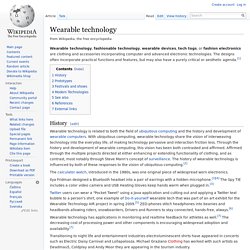
The designs often incorporate practical functions and features, but may also have a purely critical or aesthetic agenda.[1] History[edit]